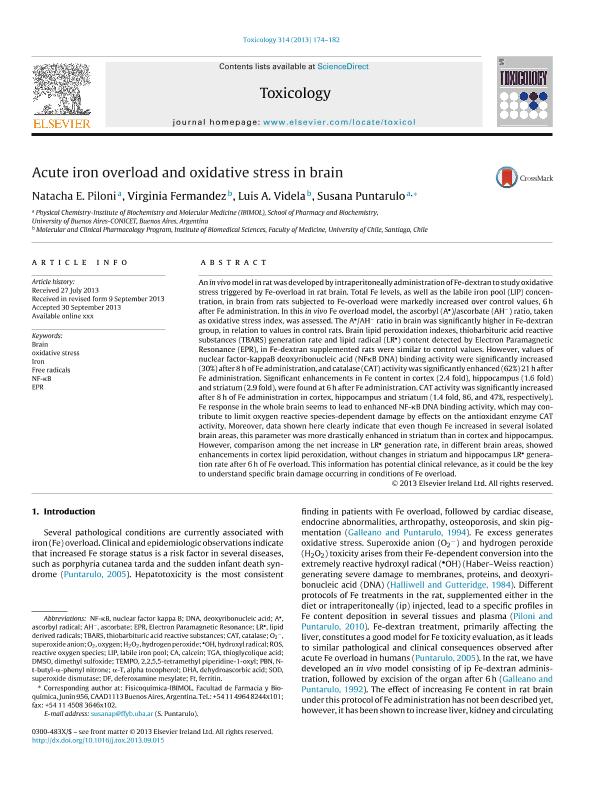Artículo
Acute iron overload and oxidative stress in brain
Fecha de publicación:
10/2013
Editorial:
Elsevier Ireland
Revista:
Toxicology
ISSN:
0300-483X
Idioma:
Inglés
Tipo de recurso:
Artículo publicado
Clasificación temática:
Resumen
An in vivo model in rat was developed by intraperitoneally administration of Fe-dextran to study oxidative stress triggered by Fe-overload in rat brain. Total Fe levels, as well as the labile iron pool (LIP) concentration, in brain from rats subjected to Fe-overload were markedly increased over control values, 6 h after Fe administration. In this in vivo Fe overload model, the ascorbyl (Aradical dot)/ascorbate (AH−) ratio, taken as oxidative stress index, was assessed. The Aradical dot/AH− ratio in brain was significantly higher in Fe-dextran group, in relation to values in control rats. Brain lipid peroxidation indexes, thiobarbituric acid reactive substances (TBARS) generation rate and lipid radical (LRradical dot) content detected by Electron Paramagnetic Resonance (EPR), in Fe-dextran supplemented rats were similar to control values. However, values of nuclear factor-kappaB deoxyribonucleic acid (NFκB DNA) binding activity were significantly increased (30%) after 8 h of Fe administration, and catalase (CAT) activity was significantly enhanced (62%) 21 h after Fe administration. Significant enhancements in Fe content in cortex (2.4 fold), hippocampus (1.6 fold) and striatum (2.9 fold), were found at 6 h after Fe administration. CAT activity was significantly increased after 8 h of Fe administration in cortex, hippocampus and striatum (1.4 fold, 86, and 47%, respectively). Fe response in the whole brain seems to lead to enhanced NF-κB DNA binding activity, which may contribute to limit oxygen reactive species-dependent damage by effects on the antioxidant enzyme CAT activity. Moreover, data shown here clearly indicate that even though Fe increased in several isolated brain areas, this parameter was more drastically enhanced in striatum than in cortex and hippocampus. However, comparison among the net increase in LRradical dot generation rate, in different brain areas, showed enhancements in cortex lipid peroxidation, without changes in striatum and hippocampus LRradical dot generation rate after 6 h of Fe overload. This information has potential clinical relevance, as it could be the key to understand specific brain damage occurring in conditions of Fe overload.
Palabras clave:
Iron
,
Brain
,
Oxidative Stress
,
Labile Iron Pool
Archivos asociados
Licencia
Identificadores
Colecciones
Articulos(IBIMOL)
Articulos de INSTITUTO DE BIOQUIMICA Y MEDICINA MOLECULAR
Articulos de INSTITUTO DE BIOQUIMICA Y MEDICINA MOLECULAR
Citación
Piloni, Natacha Estefania; Fernandez, Virginia; Videla, Luis A; Puntarulo, Susana Angela; Acute iron overload and oxidative stress in brain; Elsevier Ireland; Toxicology; 314; 1; 10-2013; 174-182
Compartir
Altmétricas




